Continued from page 1
New SubDivision Tools
“formZ 8 strives to create tools for creating design through, solid modeling, surface modeling, NURBS modeling and now subDivision modeling,” says Kropp. “It is giving a new tool for creation and exploration.”
The new SubDivision modeling technologies introduces a whole new suite of tools and new ways of accomplishing things. Knopp notes that while SubD modeling isn’t often thought of as a modeling technology for architecture, per se, it does open up a new avenue for way of creating some smooth forms very quickly.”
In a workflow sense you can actually start with a boxy type of form, use the SubD tools to create smooth forms and then convert those back to NURBS. (see image 01 above)
The advantage of SubDs is that it allows you to create shapes very quickly—more so than what you can do with NURBS—but you can go back to NURBS. “In essence SubDs allow you to do somethings best done with SubDs and then convert to another type of object like NURBS and take advantage of the functionality that formZ offers for manipulation, and export of NURBS objects,” says Kropp.
Product designers will find the SubDs the most useful but so will some architects and other types of users.
The Basic Workflow with SubDs
With any polygon shape you can convert it to a SubD. Like pretty much any other SubD tool behind the scenes you still have the faceted polygonal object but with SubDs you get a scaleable curvature-based form in a editable, draggable cage. (see image 01). A very nice tessellation of those surfaces actually lends itself very well to 3D printing. “An excellent side benefit to some of this technology—is the excellent meshes it creates,” says Matthew Holewinski, Product Specialist at AutoDesSys.

02 – formZ 8’s new Subdivision surface modeling tools include a “bridging” command as well as twist tools and more.
FormZ is known not just for having the tools to create a form but also to go back and edit a form. We always want to have some ability to go back to the original cage of the SubD and pick points to move or increase or decrease the mesh’s grid points making things smoother or less smooth.
What SubD’s are really good for are organic modeling. Users will have the ability to grab any face and move it, stretch it, increase its size, et cetera. In essence SubDs allow the user to truly sculpt a form. The SubDs tools include a bridge tool that allows a user to bridge a form across two separate forms—and this is useful for various reasons. (see image 02 above)
Using SubDs for Architectural Forms
In our online meeting Matthew Holewinski demoed all these new features and showed some architectural forms that one could imagine being used on some ceiling application perhaps. In looking at these organic forms I couldn’t help but think of the award-winning work of Spanish architect Santiago Calatrava.
In another example Matthew showed something that was a base for a table, a truly organic form that was biological and lively. The new SubD technology, as mentioned earlier, makes ideally clean meshes for 3D printing from which formZ has long been able to support out to the STL file format for 3D printers. During the presentation some sample printed output coming from SubD forms in formZ 8 direct to 3D printers were shown. The results looked excellent.
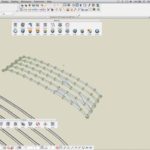
03 – formZ 8 will allow users to create serial elements like these rib forms and use the SubDs technology to add creative forms across them.
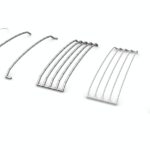
04 – This image shows the various steps taken to generate the organic ribbed form shown at the far right in the image.
In fact, one of the items shown was a piece of furniture at the scale of say 1/2 inch equals a foot. Immediately I wondered: this would be great for creating furniture for architectural models—physical models—all printed out and ready to be utilized inside an architect’s model.
Advertisement
Clearly the addition of the SubD technology will be put to good use for all kinds of product and industrial design uses by formZ users. But beyond that it also seems to be valuable in architecture for curved bodies structures, fanciful roofs, organic building shapes, including trusses and columns and even for decorative screening elements on buildings. (see images 03 – 05)
Before we leave the SubD technology and move onto other things let’s address some questions that readers may be wondering about. Taking a look back at that table structure or the rib-like structure above, those elements are solids. They started as SubDs and remain so until you translate them to something else but even if you cut through them in section, what you have is a solid. As David Kropp stated, “that’s why we can print it, first of all, and if we wanted to take it to some other application or technology. Those are solids.”
And as stated before you can also take out these SubDs to a NURBS object where either in this application or another app the solids objects from the SubDs can be taken to a higher level of accuracy and be hulled, shelled, thickened, or all the things you can typically do with NURBS tools.
It is important to note that if you start with a solid primitive and turn it into a SubD you end up with and maintain a solid despite your SubD operations. If you start with a non-solid object and work with the SubD tools you will also keep things as a surface. (see image 06 on the next page)
New Rendering Features
The new rendering technology based on the updated OpenGL adds things like soft shadows and real-time ambient occlusion, as mentioned earlier. In formZ 8 the user will have new controls for dialing up or down things like the soft shadows for instance. The new full shaded render mode is dramatically improved.
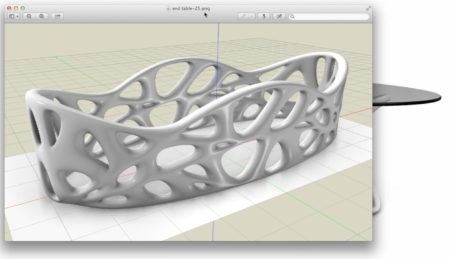
06 – This organic base for a table was created using the new SubDs technology in formZ 8. The resulting forms are solids based on high-quality meshes that are ideal for 3D printing.
In the sample image below you can see a rough approximation between the difference in rendering in formZ 7 and the new formZ 8. In the first image all shadows are turned off which is a bit different than true formZ 7 rendering. But importantly, bump mapping isn’t on, and ambient occlusion is also off. In the second image all these features are turned on—specifically the ones that are brand new due to new OpenGL improvements. (see images 07 – 08 below)
Bear in mind that this is the full shaded rendering mode not the working shaded rendering mode.
next page: Other Improvements, BIM and Something Exciting about Computation Modeling

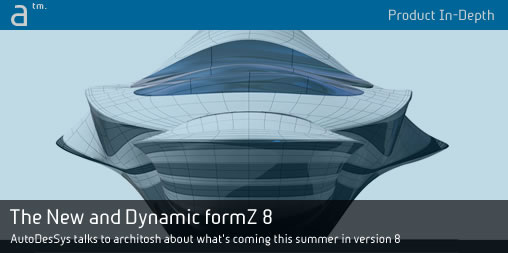
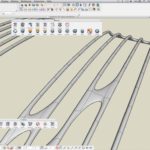


Reader Comments
#CAD In-Depth: The New and Dynamic formZ 8 – AutoDesSys, Inc., talks to Architosh about what’s coming up this su… http://t.co/BSCpN4Hkev
#CAD In-Depth: The New and Dynamic formZ 8 – AutoDesSys, Inc., talks to Architosh about what’s coming up this su… http://t.co/BSCpN4Hkev
Did you know formZ’s first 64-bit code base was written for DEC Alpha? Learn more here — http://t.co/UGoSGb5lNh
Did you know formZ’s first 64-bit code base was written for DEC Alpha? Learn more here — http://t.co/UGoSGb5lNh
FormZ is gunning for the “computational modeling” market soon — Learn more in our special feature — http://t.co/UGoSGb5lNh
FormZ is gunning for the “computational modeling” market soon — Learn more in our special feature — http://t.co/UGoSGb5lNh
@architosh I had one of those
@architosh I had one of those
#CAD In-Depth: The New and Dynamic formZ 8 – AutoDesSys, Inc., talks to Architosh about what’s coming up this su… http://t.co/BSCpN4Hkev
@AutoDesSys to Launch formZ v8 #cad http://t.co/qnd5SMWt9o
@AutoDesSys to Launch formZ v8 #cad http://t.co/qnd5SMWt9o
RT @architosh: FormZ is gunning for the “computational modeling” market soon — Learn more in our special feature — http://t.co/JZ2mYM6P93
RT @architosh: FormZ is gunning for the “computational modeling” market soon — Learn more in our special feature — http://t.co/JZ2mYM6P93
In-Depth: The New and Dynamic formZ 8 | Architosh http://t.co/8dnfwnbPHi
In-Depth: The New and Dynamic formZ 8 | Architosh http://t.co/8dnfwnbPHi
[…] next page: New SubDivision Tools […]
Comments are closed.